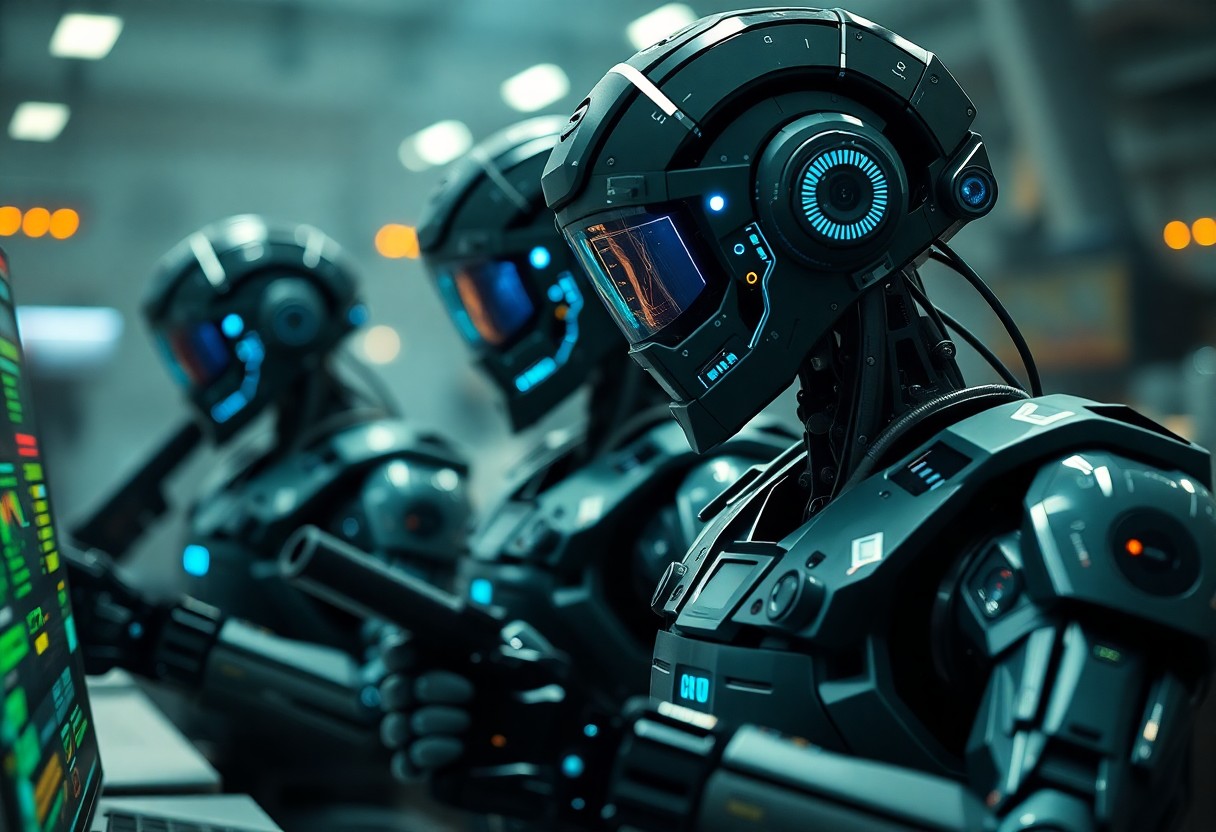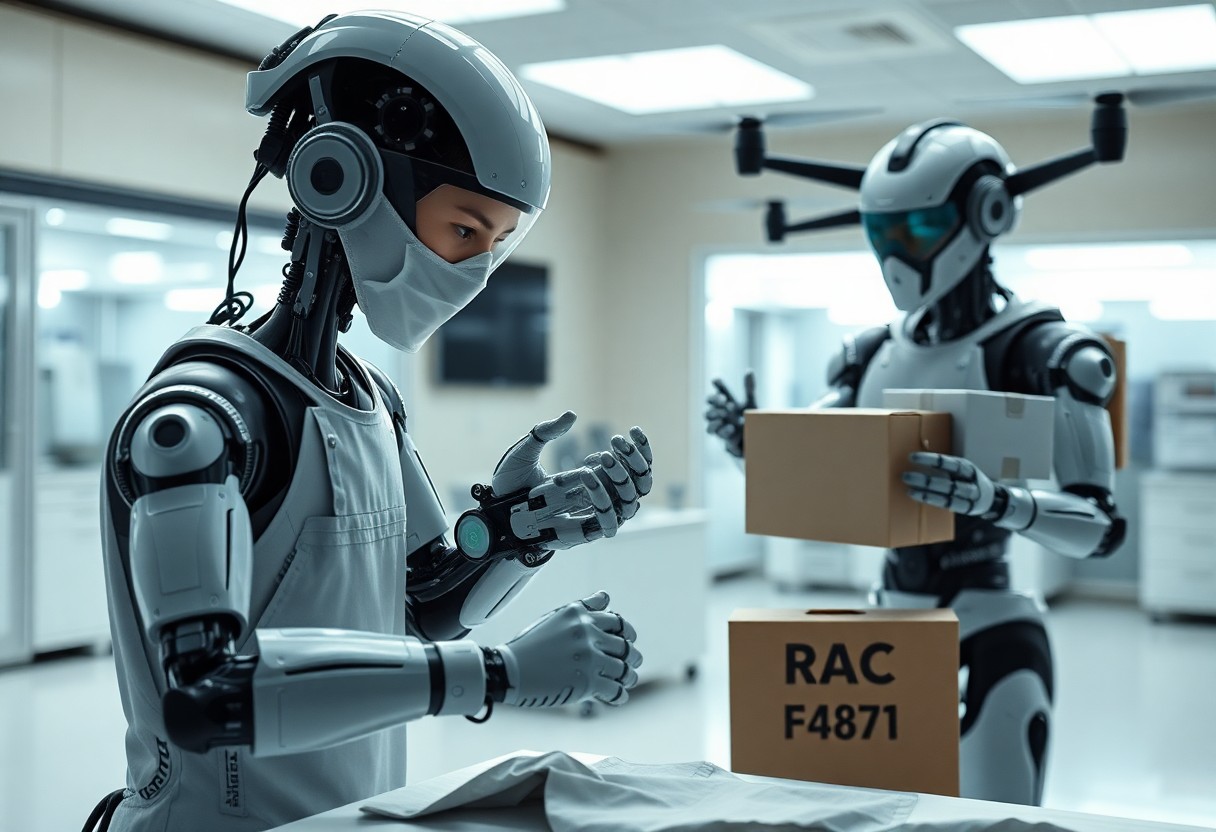Robotics has revolutionized the battlefield, integrating artificial intelligence to significantly enhance military capabilities. As you probe into the relationship between AI and military robots, you’ll discover how these advanced technologies improve efficiency and streamline decision-making processes. From autonomous vehicles to intelligent surveillance systems, the application of AI in military robotics not only optimizes operational effectiveness but also supports strategic planning. Understanding these innovations will give you insights into how modern warfare is evolving and the role that AI plays in shaping your security landscape.
Overview of Military Robots
A military robot refers to any robotic system designed to assist military operations, including surveillance, logistics, and combat roles. As technology evolves, these robots have become increasingly autonomous, supporting armed forces by performing tasks that can be dangerous for human personnel. By integrating AI, military robots can alleviate human workload, enhance operational capabilities, and ultimately save lives on the battlefield.
Historical Context
Beside traditional warfare methods, military robots have been in development since World War II, initially as simple remote-controlled vehicles and drones. Over the decades, their capabilities have significantly advanced, evolving from basic machines to sophisticated systems that incorporate advanced sensors and automation. This historical progression highlights the military’s ongoing commitment to innovation for increased effectiveness in various combat scenarios.
Current Technological Advances
With rapid advancements in AI, robotics, and sensor technologies, today’s military robots are equipped with complex systems that enhance their operational efficiency. These innovations include improved autonomous navigation, real-time data analysis, and enhanced communication capabilities, allowing robots to make informed decisions in dynamic environments.
It is fascinating to consider how these current technological advances have transformed military operations. The integration of machine learning algorithms allows robots to learn from their experiences, making them increasingly adept at navigating unpredictable scenarios. Autonomous drones and ground vehicles can now reach locations without direct human control while collecting vital intelligence. Furthermore, advanced sensors enable them to detect threats and assess situations more accurately than ever, granting military personnel the ability to operate at a higher level of preparedness. This leap in technology showcases the pivotal role these robots play in modern warfare, emphasizing their strategic importance to your military operations.
The Integration of AI in Military Robotics
The integration of AI in military robotics signifies a transformative shift in modern warfare. It empowers autonomous systems to process vast amounts of data, streamlining operations from reconnaissance to tactical strikes. As these technologies advance, you will see enhanced synergy between human operators and robotic units, optimizing mission outcomes and resource allocation. This integration not only enhances operational efficiency but also reduces risks to personnel, enabling military forces to adapt to evolving challenges.
Machine Learning Algorithms
Across numerous military applications, machine learning algorithms play a vital role in refining robotic capabilities. These algorithms enable robots to learn from historical data, identify patterns, and improve performance over time. By harnessing this technology, you will witness enhanced target recognition, predictive maintenance, and autonomous navigation, making military operations more effective and adaptable to dynamic environments.
Decision-Making Processes
Learning from vast datasets is vital for enhancing the decision-making processes in military robots. Powerful AI algorithms analyze real-time information, allowing machines to make informed decisions based on context and mission parameters.
Robotics equipped with advanced AI decision-making processes can assess multiple variables and potential scenarios beyond human capacity. By simulating various outcomes, these systems can make split-second decisions that reflect strategic military objectives. As you engage with these technologies, you will find that AI-powered autonomy enables military robots to navigate complex environments, respond to threats more effectively, and execute missions with greater precision. The evolution of these systems promises a profound impact on tactical efficiency in the battlefield.
Enhanced Efficiency Through Automation
One of the most significant advantages of AI in military robots is the enhanced efficiency provided through automation. With advanced algorithms, these robots can perform repetitive tasks at a speed and accuracy far beyond human capabilities. This level of automation allows your military personnel to focus on strategic decision-making while robots handle routine operations, ultimately increasing overall mission effectiveness.
Operational Speed and Precision
For military operations, the combination of speed and precision is a game-changer. AI-driven robots can process vast amounts of data in real-time, enabling them to navigate complex environments and execute missions with pinpoint accuracy. This capability not only minimizes the risk of error but also accelerates mission timelines, thereby enhancing your operational readiness.
Resource Allocation and Management
Between managing personnel, equipment, and logistical needs, effective resource allocation is vital for military success. AI-enabled robots contribute to this by optimizing the use of available assets, ensuring that resources are distributed where they are most needed.
To maximize efficiency, AI systems analyze data streams, user inputs, and real-time conditions, allowing for intelligent distribution of resources and assets. This insight empowers you to make informed decisions on troop deployments, equipment usage, and supply chain management, ultimately enhancing operational capabilities while reducing wastage and redundancy. By embracing this technology, your military can achieve an unprecedented level of operational synergy and adaptability.
Strategic Advantages of AI-Powered Military Robots
After integrating AI in military robots, you can expect enhanced strategic advantages that significantly boost operational efficiency. These advancements lead to improved decision-making capabilities, allowing military forces to react quickly in dynamic environments. By automating various functions, AI-powered robots ensure that your troops are better equipped to handle threats, ultimately increasing the effectiveness of military engagements.
Intelligence Gathering and Surveillance
An advanced AI system streamlines intelligence gathering and surveillance by processing vast amounts of data at incredible speeds. Your military units can leverage these insights to identify patterns, threats, and potential targets without the delays associated with traditional methods. AI-powered robots can autonomously navigate challenging terrains to gather intelligence, making your missions more efficient and informed.
Combat and Tactical Applications
After implementing AI-driven military robots in combat, you witness a transformation in tactical operations. These robots can analyze battlefield conditions in real-time, helping you make tactical decisions based on the latest data available. Incorporating AI helps in minimizing casualties and maximizing strategic success.
Plus, AI-powered military robots offer the ability to adapt to shifting battlefield dynamics, allowing you to maintain a tactical advantage over adversaries. They can engage in a variety of combat roles, from reconnaissance to direct engagement, providing real-time feedback to your command structures. This versatility enables you to deploy resources more effectively, ensuring that your operations are not only successful but also carry less risk for your personnel.
Ethical Considerations and Challenges
Unlike traditional military operations, the use of AI in robots introduces complex ethical dilemmas. You must consider not only the potential for increased efficiency but also the moral implications of autonomy and decision-making in combat. Understanding the ramifications of these technologies is crucial in navigating the future landscape of warfare and in formulating appropriate regulations.
Moral Implications of Autonomous Warfare
Across different cultures and societies, the morality surrounding autonomous warfare raises significant concerns. You face ongoing debates about the justification of using machines to make life-and-death decisions, questioning whether such actions dehumanize warfare and diminish accountability.
Accountability and Decision-Making
Moral implications extend to the accountability of decisions made by autonomous military robots. You may find it challenging to ascertain who is responsible when a machine takes an action that results in unintended consequences. The blurred lines of accountability raise significant questions regarding military ethics, operational protocols, and the necessity for a framework governing AI use in combat.
This complexity highlights the need for a clear chain of accountability in decision-making processes involving AI military robots. You should actively engage in discussions about who is responsible when AI systems fail or make erroneous judgments. These considerations necessitate the establishment of ethical guidelines and frameworks that clarify the roles of human operators, military leaders, and the technology itself while ensuring adherence to international law and humanitarian standards.
Future Trends in Military Robotics
All indications suggest that military robotics will continue to evolve, integrating advanced artificial intelligence to enhance tactical decision-making and operational efficiency. As nations invest in these technologies, you can expect a shift toward more autonomous systems, supporting soldiers on the battlefield by performing complex tasks with minimal human intervention.
Innovations on the Horizon
Military applications of robotics are seeing cutting-edge innovations that push the boundaries of AI capabilities. You will find that emerging technologies such as machine learning and swarm robotics are destined to create more resilient and adaptive military systems, enabling your forces to operate in highly contested environments while minimizing risk to personnel.
Potential Limitations and Risks
Horizon challenges persist in military robotics, even as promising innovations surface. You must consider ethical implications, operational reliability, and security vulnerabilities that could compromise critical missions and expose your forces to unforeseen threats.
At the intersection of advancement and risk lies the potential for unintended consequences in military robotics. As you explore these emerging technologies, it’s necessary to assess the ethical dimensions of autonomous weapon systems, including accountability in decision-making processes and the risk of malfunction in high-stakes scenarios. The security of AI systems is also a significant concern, as adversarial entities might exploit vulnerabilities, thereby jeopardizing both strategic outcomes and the safety of troops on the ground.
Final Words
Now, as you explore the integration of AI in military robots, it’s clear that these technologies significantly enhance efficiency and decision-making in defense operations. By leveraging AI, you can empower military personnel to perform tasks with greater speed and accuracy, ultimately leading to more informed strategic decisions. Embracing AI in military robotics not only optimizes operational capabilities but also adapts to the evolving challenges of modern warfare, ensuring that your forces are always ahead in this critical domain.






